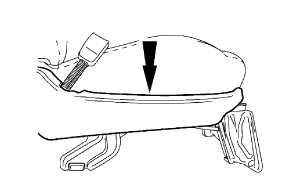• Always wear safety glasses when servicing an air-bag equipped vehicle and an air bag module. This will reduce the risk of injury if the air bag accidentally deploys.
• After deployment, the air bag surface could contain deposits of sodium hydroxide, a product of the gas generating combustion. Since it irritates your skin, wash your hands with soap and water after servicing.
• Never to probe the connectors with a tester on air bag module. If it is probed directly, the deployment of the air bag could result in personal injury.
• The air bag sensor is important for proper SRS air bag system operation. If a vehicle equipped with a SRS air bag system is involved in the collision, inspect the sensor mounting bracket and wiring harness connector for deformation. Replace damaged sensors or structural components whether or not the air bag has deployed, and install new parts properly.
• To avoid accidental deployment of the air bag and possible personal injury, always deplete the back-up power supply before repairing or replacing any front or side air bag structural component, and before servicing, replacing, adjusting, or causing impact to components near the air bag sensors, such as doors, dashboard, console, door latches, strikers, seats and bonnet latches.
• Before servicing, refer to this workshop manual to determine the location of the crash zone sensor.
• The side air bag sensors are located at the base of the B pillar.
• To deplete the back-up power supply, disconnect the battery negative cable and wait for 1 min or more. Make sure to disconnect the auxiliary batteries and power supplies (if equipped).
• The SST (diagnostic simulator) is for SRS air bag system servicing only. Before using the vehicle, you must always remove it. Failure to remove it could result in personal injury and loss of the vehicle safety standards.
